Frontier
Southwest Territory
After the effort to establish a state of Franklin failed, frontier people in Tennessee still wanted to break off from North Carolina. And by this time, North Carolina was ready to get rid of them.
Daniel Smith, a leader in the Cumberland area settlements, had attended the constitutional convention in North Carolina in 1789. The convention was held in order for North Carolina to ratify the U.S. Constitution.
While there, Smith met with the North Carolina governor and pressed for him to cede the lands to the U.S. government. One month later the North Carolina legislature gave up its claims to the western lands.
Congress accepted the lands and set up the territory south of the Ohio River as the Southwest Territory. A territorial government was established with William Blount as governor. John Sevier had hoped he would be chosen governor by President George Washington, but William Blount's political connections enabled him to be chosen instead.
Blount established the territorial capital at Piney Flats in Sullivan County using the home of William Cobb, named Rocky Mount, as his headquarters.
In 1792, Blount moved the capital to Knoxville, near James White’s fort at the French Broad and Holston rivers. Blount named the town Knoxville for U.S. Secretary of War Henry Knox.
Blount also ordered a census be taken in 1791. It showed that 35,691 people lived in the area. The chart below shows the different divisions in the census. "All other persons" are probably free blacks. Indians were not counted in the census.
|
Free white males, 21 years & older
|
6,271
|
|
Free white males under 21 years
|
10,277
|
|
Free white females, all ages
|
15,365
|
|
All other persons
|
361
|
|
Slaves
|
3,417
|
With a population this large, federal law dictated that a representative assembly should be set up. This was not done until 1793. Out of the 13 men nominated, President George Washington selected five to serve on a council. These men were John Sevier, Stockley Donelson, James Winchester, Parmenas Taylor, and Griffith Rutherford.
Much of Blount’s time was taken with Indian matters, as he was also superintendent of Indian affairs for the territory. In 1791, he met with Cherokee leaders and signed the Treaty of Holston. That treaty set new boundaries for white settlement, allowing for the first time settlements south of the French Broad River. In return, Blount offered the Cherokees an annual payment of $1,000. After Cherokee chiefs appealed directly to President Washington, this was later increased to $1,500 by the federal government.
Relations between the settlers and Indians continued to be hostile. White settlers loudly demanded protection from the federal government, but the federal leaders saw the whites as responsible for causing trouble.
Blount occasionally tried to stay on good relations with the Indian tribes, but this was unsuccessful. For example, in 1793 Blount had authorized an attack on Indians who were raiding settlements in Middle Tennessee. Unfortunately, the troops attacked the wrong village and killed a chief who was friendly to the whites.
Blount also brought a printer into the new territory to help shape public opinion. As soon as he was appointed governor, Blount asked printer George Roulstone in North Carolina to set up shop in the territory. Roulstone established the state's first newspaper, The Knoxville Gazette. The newspaper helped get out news that Blount thought was important.
A census taken in 1795 showed the population had increased to 77,262, more than the 60,000 required for statehood by federal law. Blount scheduled a vote on statehood which passed easily, 6,504 to 2,562. Most of the votes against came from the Cumberland River settlements. It is thought by historians that many wanted their own state, not one in conjunction with the eastern settlements.
With the vote for statehood, the stage was now set for a constitutional convention.
For more information about William Blount, click here.
For more information about William Blount, click here.
Picture Credits:
- A painting of William Blount, the governor of the Southwest Territory. Tennessee State Museum Collection
- A photograph of Rocky Mount at Piney Flats today, the location of the Southwest Territory capitol government. Later Blount moved the capitol to Knoxville. Courtesy of Tennessee State Photographic Services
- A photograph of the Blount Mansion in Knoxville today. Blount used the house both as his home and the capitol for the Southwest Territorial government. Courtesy of Tennessee State Photographic Services
- A photograph of Rock Castle today. Located in what is now Hendersonville, Rock Castle was built by early pioneer Daniel Smith. Smith surveyed most the site that became Nashville, and prepared the first official map of Tennessee. He later served as U.S. Senator from Tennessee. Courtesy of Tennessee State Photographic Services
- Painting showing the Knoxville Blockhouse. This painting was made by Lloyd Branson and depicts what the early fort may have looked like in 1793. Tennessee State Museum Collection
- Drawing showing a printing press. This drawing was published in 1967 by Edwin Tunis in his work, Colonial craftsmen: And the Beginnings of American Industry. It shows two men reading a document, while another works at the printing press. Tennessee State Museum Collection
Frontier >> Becoming a State >> Early Efforts >> Southwest Territory
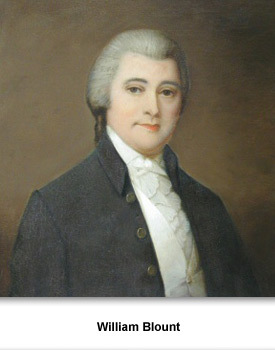
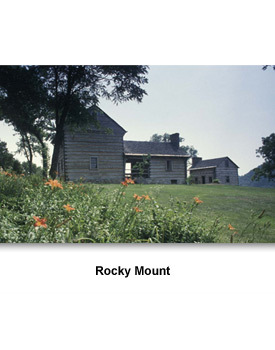
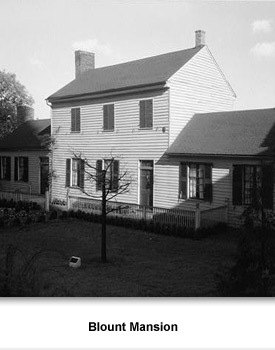
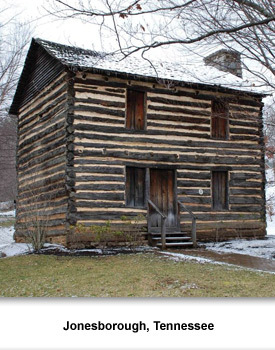
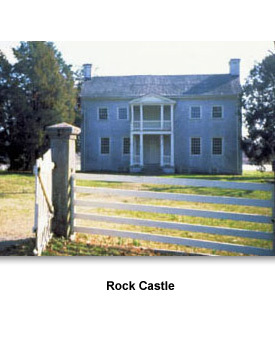
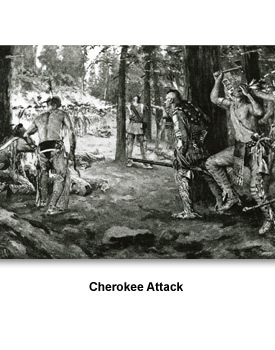
 Sponsored by: National Endowment for the Humanities
Sponsored by: National Endowment for the Humanities